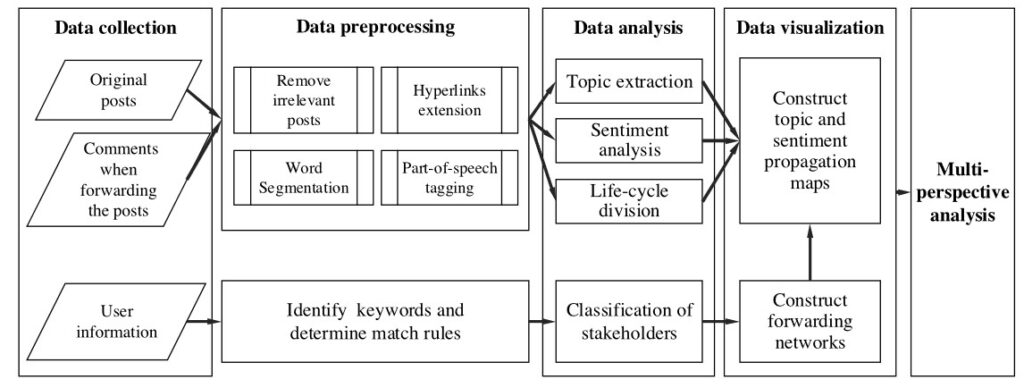Information Dissemination and Response to Public Events
Information Dissemination and Response to Public Events
Lu An and Li Zhang
What are the characteristics of information dissemination during public events? How can the information be leveraged to better respond to public events? Nowadays, social media provides convenient platforms where people can express their opinions and emotions. The public events which threaten the safety of people’s lives and property are likely to trigger a tsunami of opinions with much information disclosed at the same time (Heverin and Zach, 2012). It is a double-edged sword to spread crisis information on social media. On the one hand, it helps the event stakeholders respond to public events. Better informed people can protect themselves from the dangerous situation. On the other hand, the storm of opinions may also bring about secondary harm. Social media provides multi-channel communication platforms that allows litigants, governments, media, and ordinary people to communicate with each other directly. Thus, it makes a great contribution to the public’s perception of the crisis and information sharing. However, rumors and misinformation breed malicious emotions along with extreme views that negatively affect the public at the same time (Grover et al., 2019). The infodemic during the COVID-19 outbreak is a recent example, which could make people feel anxious, exhausted, and scared as well as distrust in governments.
—It is a double-edged sword to spread crisis information on social media.—
To cope with the crisis, the emergency management departments need to monitor public opinion in real time, understand the mechanism of event information dissemination and public opinion formation, and guide the public opinion reasonably (Zhang, Wang, & Zhu, 2020). Thus, in the context of public events, we focus on how topics and sentiments about public events spread on social media, and discuss which characteristics of social media may result in high influence in the virtual space. In addition, the method of measuring the public’s trust in government microblogs and a maturity diagnosis model of public opinion guidance ability of government microblog are proposed.
How do public event stakeholders influence others’ topics of concern and emotions?

One of our recent studies (An, Zhou, Ou, Li, Yu, and Wang, 2021) quantified the topical influence and sentiment contagion of public event stakeholders and reveal the patterns of crisis information dissemination. Figure 1 shows the general research framework. The dissemination of crisis information can be divided into four stages, i.e., the initial stage, the outbreak stage, the spread stage, and the recession stage. Eleven types of stakeholders are identified and divided into four categories including inducers, victims, responders, and onlookers (Heath, 2001). Based on the forwarding relationships among microblog entries, we construct topic and sentiment propagation maps respectively and propose four indicators to measure the topical influence and sentiment contagion of event stakeholders. The “topic out-degree” of a node (namely a user) X refers to the proportion of nodes that are directly connected with and share the same topics with the node X among all the nodes that are directly connected with the node X in a forwarding network. The “topic variation degree” of a node X is defined as the proportion of nodes that are directly connected with and share no common topic with the node X among all the nodes that are directly connected with the node X in a forwarding network. Similarly, the “sentiment out-degree” of a node X is defined as the proportion of nodes that are directly connected with and hold the same sentiment type with the node X among all the nodes that are directly connected with the node X in a forwarding network. The “sentiment variation degree” of a node X is defined as the proportion of nodes that are directly connected with and hold a different sentiment type with the node X among all the nodes that are directly connected with the node X in a fording network. The topic out-degree and topic variation degree describe the topical influence of a user, and the sentiment out-degree and sentiment variation degree describe the sentiment contagion of a user.

The child abuse case in the Beijing Red-Yellow-Blue Kindergarten was investigated and the related microblog posts were crawled. It is found that in most cases the topics varied among different stages. The sentiments between the outbreak stage and the spread stage were significantly different. In the first three stages, as the number of microblogs increased, sentiment diversity decreased. Among the users who forwarded another user’s post and involve the same topics as the latter, 61.4% of them also had the same sentiments as the latter. The governments and mainstream media had the greatest topical influence and sentiment contagion. For the litigants, governments, the Communist Youth League, we-media, and enterprises, their topic out-degrees were negatively related to their sentiment-outdegrees. But for ordinary people, the two indicators were positively related. In most cases, information spread from high-topic/sentiment influence stakeholders to low-topic/sentiment influence stakeholders, but exceptions also exist.
Why do some microblog posts have high influence in the context of public events?
Our recent paper (An et al, 2021) developed a prediction model of microblogging influence in the context of public events based on the logistic regression model. The number of forwarding, comments, and likes of a microblog post were collected and used to measure the influence of a microblog post. A number of indicators are identified regarding the time, content, and user characteristics of microblogging. The H-index is employed to measure the influence of a topic. Experiment results show that the prediction model based on the logistic regression model can successfully predict the influence of 85.7% of microblog posts, which has better performance than the C4.5 decision tree, Bayesian belief network, naive Bayes, random forest, multilayer perceptron, and support vector machine methods. The text structure, user’s industry, and the authentication type are the three most important characteristics. See Figure 2. We-media, individual group organizations, platform accreditation, and users belonging to the public security system tend to exhibit high influence.

How to assess netizens’ trust in government microblogs in the context of public events?
One of our recent studies (An and Xu, 2022) proposed a method to assess netizen’s trust in government microblogs from the perspectives of likes, forwarding, and comments. As comments are very complex and cannot be directly counted as likes and forwarding, a novel approach is proposed to determine whether the commenter trust a government post. See Table 1 for the rules. They are as follows. If the sentiment of a government post is negative and the government post and the comment share similar topics, the trust value of a comment is opposite to the sentiment of the comment. If the government post is neutral and the government post and the comment share similar topics, the trust value of a comment is zero. Otherwise, the trust value of a comment equals the sentiment of the comment. The proposed method is used to assess the trust of netizens in government microblogs during the COVID-19 epidemic.
It is found that netizens’ trust in government microblogs varies over time. There are differences between individual government departments’ microblogs. Topics related to industries fighting against the epidemic can improve trust while topics related to epidemics abroad have no significant impact on trust. The impact of topics related to government actions and domestic epidemics depends on the severity of the epidemic. The public’s trust in the health microblogging (such as Health China) is mainly affected by the transparency and timeliness of the publication of the confirmed data at various stages. During the outbreak and continuation stages of the epidemic, the accurate refutation of rumors and knowledge popularization by the scientific and technological microblogging (such as Voice of the Chinese Academy of Sciences) and the measures to solve the problem of material shortage issued by the industry and information technology microblogging (such as Industry and Information Technology Microblog) can enhance the public’s trust in them.
Table 1. The rules of trust for each comment
Rule No. | Post sentiment | Comment sentiment | Similarity between topics | Trust | Example |
1 | — | Positive (comment on microblogger) | — | Tend to trust | “Immortal blogger! Express love to workers behind the scenes!” |
2 | — | Negative (comment on microblogger) | — | Tend to distrust | “Why are you qualified to name yourself as Voice of Women” |
3 | positive | Positive (comment on event) | — | Tend to trust | “Well done! Front line medical staff” |
4 | positive | Negative (comment on event) | similar | Tend to distrust | “I don’t know where the 100,000 masks are. I can’t make an appointment at all. It’s a lie! “ |
5 | dissimilar | Tend to distrust (Other appeals have not been resolved) | “Oppose the regulations on permanent residence of foreigners!” | ||
6 | negative | Positive (comment on event) | similar | Tend to distrust | “He is not a rumor monger. He is a hero in the hearts of citizens.” |
7 | dissimilar | Tend to trust | “Cheer up in the new year!” | ||
8 | negative | Negative (comment on event) | similar | Tend to trust | “I’m really speechless. Those who run around have no heart at all.” |
9 | dissimilar | Tend to distrust (Other appeals have not been resolved) | “When will the Red Cross be investigated? When will the materials be delivered to the first-line hospital?” | ||
10 | neutral | Positive/negative (comment on event) | similar | Tend to be neutral (discussion about event) | “The situation in Jiangsu is also very grim.” |
11 | dissimilar | Depend on the sentiment of the comment | (the same as rule 7 and 5) | ||
12 | — | Neutral (comment on event / on microblogger) | — | Tend to be neutral | “Whitening and blackening are just personal aesthetic.” |
(Note: — indicates that the value in this column does not need to be considered in this rule.) | |||||
How do government microbloggers perform in public opinion guidance during public events?
One of our recent studies (An and Wu, 2022) constructed a maturity diagnosis model of public opinion guidance capability of government microblogging in the context of public events. The model consists of a number of indicators in five dimensions, i.e., the basic information of a microblog account, the release of information, agenda setting, interaction, and the influence of microblog posts. The entropy method is employed to assign the weight to each indicator. We crawl the posts, comments, and users’ data of government microbloggers in Dalian, Shenyang, Changchun, and Shijiazhuang regarding the rebound of the COVID-19 epidemic in four cities. It is found that the agenda setting, the release of information, and interaction dimensions have more influence than others on the maturity level of public opinion guidance capability. The public opinion guidance capability of government microbloggers is divided into four levels, i.e., conscious, standardized, effective, and efficient levels. See Figure 3. The distribution of the public opinion guidance capability of government microbloggers presents a pyramid shape with about 8.3% of government microbloggers reaching the efficient level and 41.7% at the conscious level.

Conclusion
In the context of public events, emergency response departments need to understand the information dissemination patters and take measures to mitigate the harm caused by the public events. To predict the influence of online information can help identify potential risks and problems so that plans can be made in advance. To cope with public events, the trust and support of the public are indispensable. To reveal the key factors that affect the public’s trust in governments can facilitate the improvement of government information dissemination behaviors and mechanism. As the rumors and extreme emotions may exacerbate the event (Kwon, Bang, Egnoto, & Rao, 2016), the governments also need to cultivate the public opinion guidance capability. Our studies reveal the patterns of information dissemination on social media. The findings can help management departments take targeted measures and improve their emergency response capability in addressing public crises that may arise in the future.
References
An, L., Han, Y., Yi, Y., Li, G. and Yu, C. (2021). Prediction and evolution of the influence of microblog entries in the context of terrorist events. Social Science Computer Review, DOI: 10.1177/08944393211029193
An, L. and Wu, Y. (2022). Maturity diagnosis model of public opinion guidance capability of government microblogging in the context of public emergencies. Information Studies: Theory and Application, https://kns.cnki.net/kcms/detail/11.1762.g3.20220124.1903.006.html
An, L. and Xu, M. (2022). Calculation of netizens’ trust in government microblogs in the context of public health emergencies. Data Analysis and Knowledge Discovery, 6(1), 55-68.
An, L., Zhou, W., Ou, M., Li, G., Yu, C. and Wang, X. (2021). Measuring and profiling the topical influence and sentiment contagion of public event stakeholders. International Journal of Information Management, 58, 102327. doi: 10.1016/j.ijinfomgt.2021.102327
Grover, P., Kar, A. K., Dwivedi, Y. K., & Janssen, M. (2019). Polarization and acculturation in US Election 2016 outcomes – Can twitter analytics predict changes in voting preferences. Technological Forecasting and Social Change, 145, 438–460. Doi: 10.1016/j.techfore.2018.09.009.
Heath, R. (2001). Crisis Management (pp. 22–24). Beijing: Citic Press.
Heverin, T., & Zach, L. (2012). Use of microblogging for collective sense-making during violent crises: A study of three campus shootings. Journal of the American Society for Information Science and Technology, 63(1), 34–47.
Kwon, K. H., Bang, C. C., Egnoto, M., & Rao, H. R. (2016). Social media rumors as improvised public opinion: Semantic network analyses of twitter discourses during Korean saber rattling 2013. Asian Journal of Communication, 26. Doi: 10.1080/01292986.2015.1130157.
Zhang, W., Wang, M., & Zhu, Y. C. (2020). Does government information release really matter in regulating contagion-evolution of negative emotion during public emergencies? From the perspective of cognitive big data analytics. International Journal of Information Management, 50, 498–514.
Cite this article in APA as: An, L. & Zhang, L. (2022, October 18). Information dissemination and response to public events. Information Matters, Vol. 2, Issue 10. https://informationmatters.org/2022/10/information-dissemination-and-response-to-public-events/
Author
-
Dr. Lu An is a professor at the School of Information Management, Wuhan University, China. She is the deputy director of the Ethics Committee of Humanities and Social Sciences of Wuhan University, and director of the Research Office of Data Management and Knowledge Service at the Center for Studies of Information Resources of Wuhan University. She has published two monographs and more than 100 journal articles on International Journal of Information Management, Information Processing & Management, Telematics and Informatics, Social Science Computer Review, and so forth. She is the principle investigator of the Major Project of the Ministry of Education of China and the projects funded by the National Natural Science Foundation of China. Her research interests include social media analysis and crisis informatics. She serves as the Chair of SIG-KM of the Association for Information Science and Technology (ASIS&T) and a director of the International Society for knowledge Organization (ISKO). She can be contacted at [email protected].
View all posts





